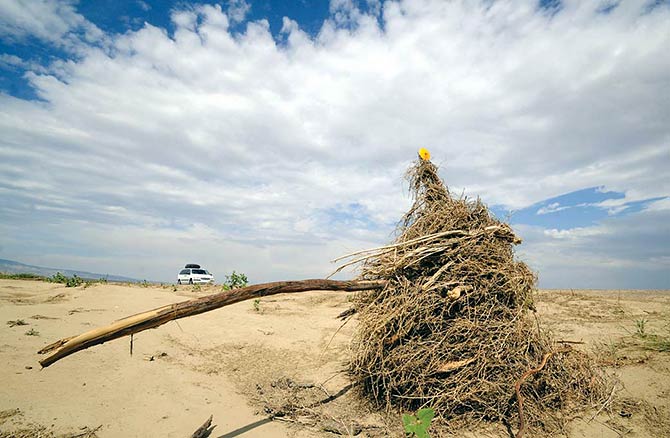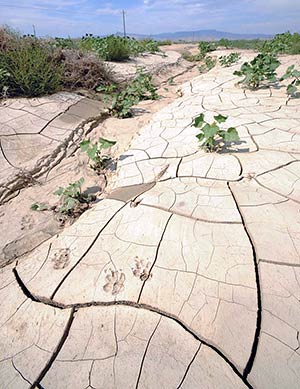'The longest drought'

(Special to the Times - Donovan Quintero)
A highway marker covered in debris is barely recognizable to passing drivers on U.S. Highway 491 near Twin Lakes, N.M. Drought continues to remain in affect despite recent rainfalls. Drought also causes flash floods because there is nothing holding down the soil.
Committee hears reports about the impacts of climate change
By Cindy Yurth
Tséyi' Bureau
MANY FARMS, Ariz., Sept. 5, 2011

(Special to the Times - Donovan Quintero)
Paw prints are imprinted in drying clay near Twin Lakes, N.M. Local and regional experts advised a Council committee that the Navajo Nation is in the midst of its longest drought ever.
After hearing reports on the issue from everybody from scientists to grazing officials to peacemakers, the committee's chairperson, Katherine Benally (Chilchinbeto/Dennehotso/ Kayenta), promised action.
"We are legislators and we aim to do that," she told the crowd of about 120 that met at the Many Farms Chapter House to discuss the alarming desertification that has taken place on the Navajo Nation in the last 30 years.
"(Your comments) will not just be put to the wayside. We will pull it all together ... above all our concern is for our Mother Earth," Benally said.
The Council, however, is getting an extremely late start. Margaret Hiza Redsteer, project chief with the U.S. Geological Survey, showed slide after slide of evidence the land has been on a consistent downward slide since at least the mid-1970s.
"The Navajo Nation is in one of the longest droughts in recorded history," she told a sea of grim-faced Central Agency residents sweating in the 90-degree heat. "It's not a simple matter of overgrazing. There are a number of other factors that make it so critical to address this issue."
Before she drew this conclusion, Redsteer had analyzed National Weather Service data, set up monitoring sites on the reservation, and interviewed 73 traditional elders to see if they had witnessed climate change in their lifetimes.
They had. Some remembered the ground being moist until the Fourth of July when they were children.
"I don't think it's been like that for a really long time," Redsteer said.
Climate data, admittedly spotty on the reservation, show a drying trend since 1944 and a warming trend since the mid-1970s.
A map of intermittent streams that used to run year-round in the 1960s showed only one that is still dependable.
In most Navajo Nation chapters, the average temperature increased nearly four degrees between the 1960s and the past decade.
The average snowfall has also decreased, which is a big deal.
"Snow is like water in the bank," Redsteer explained. "It takes a long time to melt. It soaks into the ground slowly."
Sand dunes spreading
Perhaps the most disconcerting data were on the sand dunes that started to appear on the Navajo Nation in the 1950s.
Today, Redsteer said, dunes cover about a third of the Navajo Nation, and they're getting worse. In one part of Western Agency, they are advancing at about 160 feet per year.
Several Teesto Chapter residents were stranded over Memorial Day weekend when huge dunes blew across their road, blocking passage.
Long-term weather predictions show the conditions haven't even begun to bottom out. The Southwest could get 40 percent drier, and if the area gains another 10 degrees of average temperature, it will lose two inches of rainfall. Storms will be more severe, and invasive species will take over where native grasses once held sway.
Redsteer said the data is alarming enough even to her that she has instigated her own little projects, organizing teenagers to make mud balls of native seeds and draping nearby dunes in stabilizing materials given to her by visiting scientists from the Gobi Desert.
But "it's like putting a thimble over my head to try to stay dry in a downpour," she said.
John Leeper of the Navajo Nation Water Resources Department couldn't offer any solace.
Adapting to climate change "has to be a huge priority for the Navajo Nation," Leeper told the committee, noting that every public water system on the rez, not to mention the $20 million livestock industry, are under siege by the drought.
Action will have to be comprehensive, however. Grazing officials complained that their hands are tied by the web of regulations surrounding the roundup of feral horses, which by all estimates are doing immense damage to the surviving range.
Leo Watchman of the Navajo Department of Agriculture said his department is too understaffed and underfunded to do much, and that was seconded by Resource Enforcement Officer Jonathan Dover.
Dover blamed the people's skill at raising livestock.
"Everyone here knows how to raise livestock in places they can't exist," he stated. 'The land does not support the livestock any more, and we're still successful at raising them."
Others, however, pointed out that success is relative. Hardly anyone is making a profit from their livestock any more; they've become expensive pets.
Ideas to help
Glenda Davis, head of the tribe's Veterinary and Livestock Department, said even rounding up and selling the surplus horses is a losing proposition.
With all the horse-packing plants in the U.S. shut down by animal rights lobbies, the animals must be transported to Mexico - after being separated by sex, age and brand, castrated, tested for Coggins disease and micro-chipped.
Totaling the costs associated with four recent roundups and the price paid for the resulting horsemeat, the Navajo Nation went nearly $7,000 in the hole (however, Davis noted, it saved half a million gallons of water and nearly two million tons of feed by getting those horses off the range).
Davis suggested an aggressive campaign of gelding feral stallions and injecting mares with contraceptives.
Theo Shorty, a consultant for the community nonprofit Ramah Navajo Foods, encouraged the committee to look at the demise of American slaughterhouses as "an opportunity."
If the Navajo Nation could lure in a packing company to build a facility that could process horses as well as Navajo beef and mutton, it could use its sovereign status to negotiate directly with the federal government for USDA inspection - the perk that was denied the other horse-packing plants by federal legislation, and sent the packers packing.
"Then we could take horses from surrounding states that are having the same problem we are," Shorty advised.
But Harold Russell, supervising natural resource specialist for the BIA's Navajo Region, opined that range recovery will take more than just getting surplus animals off the range. A fundamental overhaul of the grazing laws - indeed, the whole mentality of grazing permits - is what's needed, from the bureaucrat's perspective.
Russell pointed out that different regulations govern Eastern Agency, New Lands and the recently re-issued grazing permits on the former Joint Use Area.
While the relationship and enforcement authorities are clearly delineated in the satellite areas and Eastern Agency, the majority of the reservation is governed by CFR 167, which Russell characterized as a vague, hastily written law to give the tribe more authority but which actually causes confusion and conflicts.
With the caveat that the BIA's job is to support the tribe and not order it around, Russell suggested the committee rewrite the law and also train permittees that grazing permits are "a privilege to use surface vegetation" and not a land title.
"The Nation needs to gain control of their land," Russell said. "Economic opportunities are being lost as a result of one family saying, 'That's our land, and I've got a big old 30.06 and I'm not afraid to use it.'"
Russell also suggested the tribe stop fractionating grazing permits. As a result of probate and peacemaking, he noted, Chinle Agency's original 400 permits have multiplied into 1,475 - each allotment too small for anyone to make a decent living from it.
And, he added, the nation needs to take the drastic step of not issuing any more permits for horses.
"That's not to say you can't have a horse," he said. "It's got to be in a corral and you've got to feed it. It can't be out on the range."
After a full day of talking about climate change, however, it was evident not everybody is a convert.
Jones Begay, a rancher on Black Mesa, said he hasn't seen much evidence of warming up in the mountains, where the springs still flow, the grass still grows and snowstorms strand people for weeks at a time.
Asked if he believes the desert could start creeping higher, he conceded it could happen - but he doesn't believe that because of anything he heard at the meeting.
"It's in the Bible," said Begay, a regular at the Friends Church. "I don't believe the professors, but I believe God."

